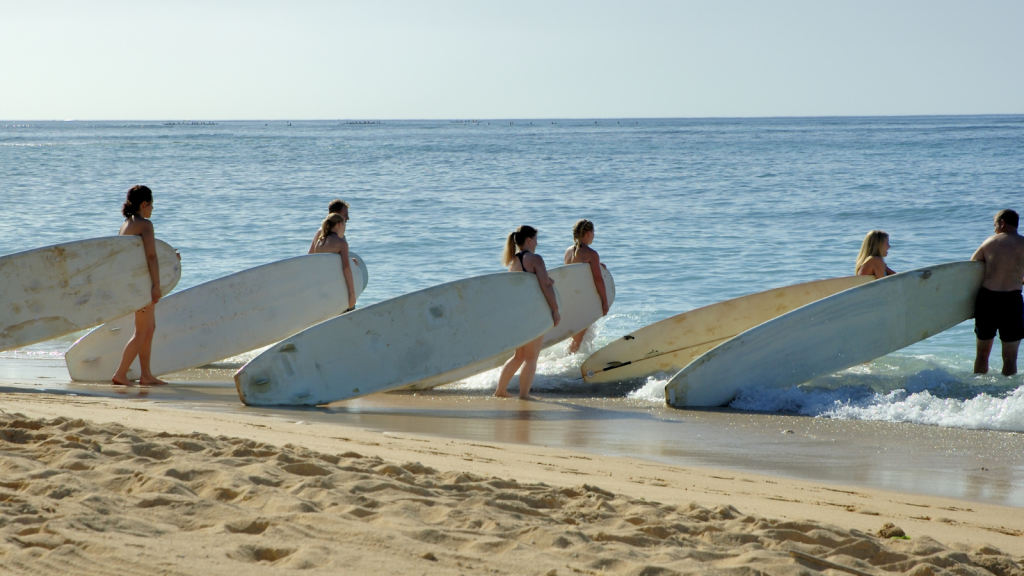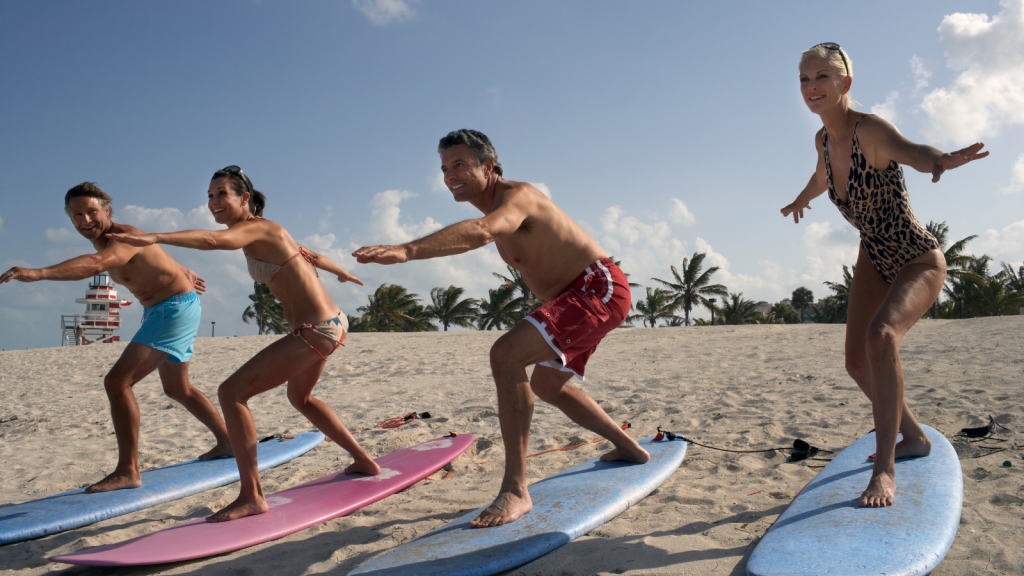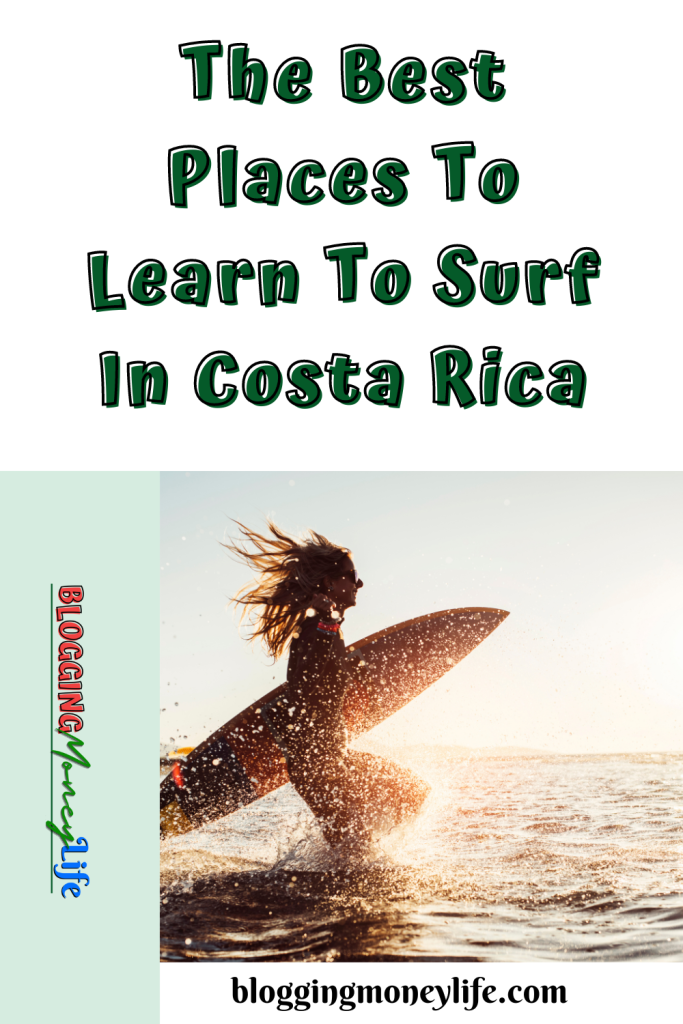The Best Places To Learn To Surf In Costa Rica

Costa Rica has the best surfing beaches between the Pacific and Caribbean coasts. The country’s stunning coastline, warm water, and smaller waves make it one of the best surf spots for beginner surfers worldwide. Costa Rica offers plenty of surf spots to suit every skill level and preference, perfect for a beginner looking to catch your first wave or an experienced surfer seeking new challenges. From Tamarindo’s laid-back vibes to Dominical’s rugged beauty, there’s something for everyone in this surfing haven.
Getting Started with Surfing
When starting out with surfing, understanding the essential components of a surfboard is the first thing to do. Surfboards come in various shapes, sizes, and materials, each designed for different surfing conditions and skill levels.
Beginners typically start with a soft-top or foam surfboard, as they provide more stability and forgiveness when learning to balance and paddle on the waves. These boards are often larger and more buoyant, making them easier to paddle and catch waves with.
To give you an insight, here are the critical components of a surfboard:
- Deck: The top surface of the board where the surfer stands.
- Rails: The edges of the board that help with maneuverability and control.
- Bottom: The underside of the board, which can be flat, concave, or convex, affects the board’s performance on the waves.
- Fins: Fins help stabilize the board and provide directional control. They can be fixed or removable, with different configurations depending on the type of surfing and conditions.
Essential Safety Tips
Safety should always be a top priority when surfing, especially for beginners still learning the ropes. Here are some essential safety tips to keep in mind:
- Know Your Limits: Start in smaller surf and gradually work up to more giant waves as you gain experience and confidence.
- Wear a Leash: Always attach a leash to your ankle or board to prevent your board from drifting away if you fall off.
- Respect the Ocean: Be aware of local conditions like currents, tides, and hazards like rocks or reefs. Pay attention to weather forecasts, and never surf alone.
- Learn Surf Etiquette: Understand the lineup rules, such as who has the right of way on a wave and how to share waves courteously with other surfers.
- Practice Good Paddling Technique: Efficient paddling is essential for catching waves and navigating the lineup. Keep your arms straight, cup your hands, and use your core muscles to power your strokes.
- Fall Safely: Learn how to fall correctly to avoid injury. Aim to fall away from your board and cover your head with your arms to protect yourself.
- Know First Aid: Familiarize yourself with basic first aid techniques, such as treating cuts, scrapes, and jellyfish stings, in emergencies.
By understanding surfboards and following essential safety tips, beginners can confidently approach surfing and enjoy safe and rewarding long rides in the water.
Choosing the Right Surf School

Before committing to a surf school, conducting thorough research is essential to find one that aligns with your needs and goals. Here are some steps to consider:
- Location: Determine the location of the surf school and whether it’s convenient for you to access. Consider factors such as proximity to accommodation, transportation options, and the surf conditions in the area.
- Instructors: Research the qualifications and experience of the instructors at the surf school. Look for certified instructors with a proven track record of teaching surfers of all skill levels.
- Facilities: Evaluate the facilities and equipment provided by the surf school. Check if they offer a variety of surfboards suited to different skill levels and conditions. Also, inquire about amenities such as changing rooms, showers, and storage for your belongings.
- Lesson Structure: Understand the lesson structure and curriculum offered by the surf school. Determine whether they offer private or group lessons and the duration and frequency of sessions. A well-structured curriculum tailored to your skill level can accelerate your progress and enhance your learning experience.
Reading Reviews
Reading reviews from past students can provide valuable insights into the quality of instruction and overall experience offered by a surf school. Here’s how to approach reading reviews:
- Online Platforms: Utilize online platforms such as Google, TripAdvisor, and Yelp to read reviews and ratings of surf schools in your desired location. Respond to positive and negative reviews to comprehensively understand the surf school’s strengths and weaknesses.
- Testimonials: Look for testimonials and success stories past students share on the surf school’s website or social media channels. Hearing about real experiences from fellow surfers can help you know the school’s credibility and reputation.
- Ask for Recommendations: Reach out to friends, family, or fellow surfers who have attended surf schools in Costa Rica for recommendations. Personal recommendations can provide valuable insights and help you narrow down your options.
Budget-Friendly Options
Surfing can be expensive, but budget-friendly options are available for those looking to learn without breaking the bank. Here are some tips for finding affordable surf schools:
- Compare Prices: Research multiple surf schools’ lessons, rentals, and package prices. Look for promotions or discounts offered for booking multiple lessons or group sessions.
- Off-Peak Seasons: Consider traveling during the off-peak seasons, such as the rainy season, to take advantage of lower rates and fewer crowds. Many surf schools offer discounted rates during these times to attract visitors.
- Group Lessons: Go for group lessons instead of private sessions to save on costs. Group lessons are often more affordable and provide the added benefit of learning alongside other surfers, fostering a sense of camaraderie and shared experience.
By researching surf schools, reading reviews, and exploring budget-friendly options, you’ll come up with a great choice that fits your needs and budget, ensuring a memorable and rewarding surfing experience in Costa Rica.
Top Surf Spots in Costa Rica

Tamarindo Beach: A Surfer’s Haven
Tamarindo is a busy beach town on the Pacific coast of Costa Rica, popular for its consistent waves and lively surf culture.
- Tamarindo Surf Lessons: Tamarindo offers plenty of surf schools catering to beginners and more advanced surfers. Whether you’re a beginner looking to catch your first wave or an experienced rider seeking to improve your skills, you’ll find qualified instructors ready to help you achieve your surfing goals.
- Beach Life Beyond Surfing: Besides its world-class surf breaks, Tamarindo offers fun activities for visitors. From exploring nearby beautiful beaches, national parks, and wildlife reserves to indulging in delicious cuisine at beachfront restaurants, Tamarindo has something for everyone to enjoy beyond the waves.
Jaco Beach: Where Waves Await
Located just a short drive from the capital city of San Jose, Jaco Beach is a popular destination for surfers seeking adrenaline-pumping rides and interesting nightlife.
- Jaco Surf Schools: Jaco has a variety of surf schools offering comprehensive lessons for surfers of all levels. If you and your friends are new surfers who want to learn the basics or advanced surfers seeking to hone their skills, Jaco’s experienced instructors will help you reach your full potential in the water.
- Exploring Jaco’s Vibes: Aside from its world-class surf breaks, Jaco offers a lively atmosphere with a massive selection of bars, restaurants, and shops lining its busy streets. Visitors can enjoy and participate in the local culture, taste traditional cuisine, and dance the night away at beachfront clubs.
Dominical Beach: Serenity and Swells
Dominical is a town known to be a great spot for surfing located along the southern Pacific coast of Costa Rica, known for its consistent swells and breathtaking natural beauty.
- Dominical Surfing Experience: Dominical’s consistent waves and uncrowded lineup make it an ideal destination for surfers seeking serenity and solitude in the water.
- Nature’s beauty Surrounding: With lush rainforests and pristine beaches, Dominical offers plenty of outdoor adventure and exploration opportunities. It is also a great spot to hike through nearby national parks, enjoy zip-line through the canopy, or simply relax and unwind on the beach, soaking in the stunning scenery surrounding them.
Each of these surf spots in Costa Rica offers unique charm and appeal, providing surfers unforgettable experiences in and out of the water. If you’re seeking consistent waves, a great place to enjoy the nightlife, or appreciate natural beauty, Costa Rica has something for every type of surfer to enjoy.
Surfing Etiquette in Costa Rica
Respecting the local surf community is a part of safety measures during your surf trip in Costa Rica. Here’s how to show respect to fellow surfers:
- Wait Your Turn: Respect the lineup and wait your turn to catch waves. Avoid paddling around or “snaking” other surfers, as this can lead to tension and conflicts in the water. You can expect a much longer waiting time during the high season, so patience is highly suggested.
- Communicate: Use clear communication with other surfers to avoid collisions and maintain safety in the lineup. Signal your intentions and be aware of surfers around you to prevent accidents.
- Be Courteous: Practice good sportsmanship and show consideration for other surfers. Offer encouragement and support to fellow surfers, especially beginners, and avoid aggressive behavior or hostility in the water.
Adhering to Beach Rules
Adhering to beach rules and regulations helps ensure a safe and enjoyable experience. Here are some critical beach rules to follow:
- Know the Local Rules: Familiarize yourself with specific rules or regulations governing surfing at the beach you visit. These may include designated surfing areas, prohibited activities, and safety guidelines.
- Respect Wildlife: Costa Rica is home to various marine life, including sea turtles and coral reefs. Be mindful of protected areas and avoid disturbing or harming wildlife while surfing.
- Dispose of Waste Properly: Help keep Costa Rica’s beaches clean by properly disposing of waste and recycling whenever possible. Avoid littering or leaving trash behind, and encourage others to do the same to preserve the coastline’s natural beauty.
Eco-Friendly Surfing Practices

Practicing eco-friendly surfing is essential for preserving Costa Rica’s marine environment. Here are some eco-friendly practices to integrate into your surfing routine:
- Use Reef-Safe Sunscreen: Choose reef-safe sunscreen products free from harmful chemicals that can damage coral reefs and marine life. Opt for mineral-based sunscreens that provide adequate protection without polluting the ocean.
- Reduce Plastic Use: Minimize using single-use plastics such as water bottles, bags, and packaging. Bring reusable water bottles and bags to the beach and participate in beach clean-up efforts to remove plastic debris from the coastline.
- Support Sustainable Surf Brands: Choose surf gear and apparel from companies prioritizing sustainability and ethical production practices. Look for brands that use eco-friendly materials, reduce waste, and support environmental conservation efforts.
By respecting local surfers, adhering to beach rules, and practicing eco-friendly surfing practices, you can contribute to a positive surfing culture and help protect Costa Rica’s pristine coastal ecosystems for future generations.
Conclusion
Costa Rica, with its captivating beauty and welcoming surf culture, is the perfect place for surfers of all levels. Nestled between the Pacific Ocean and the Caribbean coast, this tropical haven offers the best spots, boasting warm waters and gentle waves, making it an ideal playground for beginners and veteran surfers.
From the sandy bottom of Tamarindo to the great waves of Dominical, each surf spot in Costa Rica holds its own charm. Beginners can take their first steps on the board under the guidance of experienced instructors, while advanced surfers can challenge themselves with bigger swells and long rides.
Getting started with surfing is mastering the art of balancing on a board, understanding the ocean’s dynamics, and implementing safety measures. Whether learning about surfboard components or practicing essential safety tips, surfers beginning their Costa Rican adventure have the knowledge and skills necessary for a fulfilling experience.
Choosing the right surf school is essential, and diligent research and reading reviews ensure surfers find a school that aligns with their needs and aspirations. With plenty of budget-friendly options, surfing in Costa Rica becomes accessible, promising an enjoyable journey filled with waves and wonder.
Top surf spots like Tamarindo, Jaco Beach, and Dominical entice surfers with their pristine beaches and consistent swells. Aside from surfing, these destinations offer lifetime experiences, from exploring lush rainforests to indulging in lively nightlife, enriching the overall adventure.

